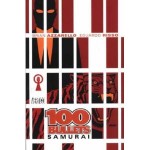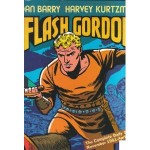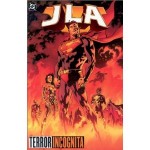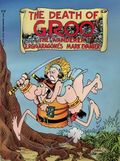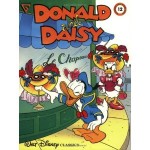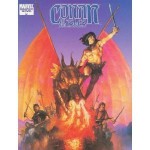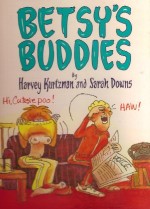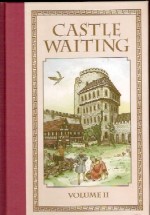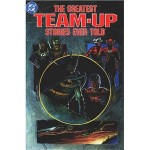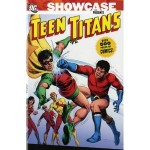
By Bob Haney, Nick Cardy & various (DC Comics)
ISBN: 978-1-84576-677-1
It’s hard to grasp now that once kid heroes were a rarity and during the beginning of the Silver Age, often considered a liability. Now the massive brand that is the Teen Titans (with numerous comicbook iterations, a superbly successful TV show and even an award-winning early reading comic (Aw, Yeaah! Tiny Titans!) their continuance is as assured as anything in our biz, but during the tumultuous 1960s the series – never a great seller – courted controversy and an actual teenaged readership by confronting controversial issues head on.
I must have been just lucky, because these stories of lost youth searching for meaning were released just as I turned into a teenager. They resonated because they were talking directly to me. It didn’t hurt that they were brilliantly written, fantastically illustrated and staggeringly fresh and contemporary. I’m delighted to declare that age hasn’t diminished their quality or impact either, merely cemented their worth and importance.
The concept of underage hero-teams was not a new one when the Batman TV show prompted DC to entrust the big heroes’ assorted sidekicks with their own regular comic in a hip and groovy ensemble as dedicated to helping kids as they were to stamping out insidious evil.
The biggest difference between wartime groups like The Young Allies, Boy Commandos and Newsboy Legion or such 1950s holdovers as The Little Wise Guys or Boys Ranch and the creation of the Titans was quite simply the burgeoning phenomena of “The Teenager†as a discrete social and commercial force. These were kids who could be allowed to do things themselves (within reason) without constant adult help or supervision. As early as June-July 1964 Brave and the Bold #54 had tested the waters with a gripping tale by Bob Haney & Bruno Premiani in which Kid Flash, Aqualad and Robin thwarted a modern-day Pied Piper.
What had been a straight team-up was formalised a year later when the heroes reunited and included Wonder Girl in a proper super-group with a team-name: Teen Titans. With this second collected volume of those early exploits the series had hit a creative peak, with spectacular, groundbreaking artwork and fresh, different stories that increasingly showed youngsters had opinions and attitudes of their own – and often that they could be at odds with those of their mystery-men mentors…
Collecting Teen Titans #19-36, and the team-up appearances from Brave and the Bold #83 and 94 and World’s Finest Comics #205, these stories cover the most significant period of social and political unrest in American history and do it from the perspective of the underdogs, the seekers, the rebels…
The wonderment begins with a beautifully realised comedy-thriller as boy Bowman Speedy joins the team. ‘Teen Titans: Stepping Stones for a Giant Killer!’ (#19, January/February 1969) by Mike Friedrich, Gil Kane & Wally Wood, pitted the team against youthful criminal mastermind Punch who planned to kill the Justice League of America and thought a trial run against the junior division a smart idea…
Brave and the Bold # 83 (April-May 1969) took a radical turn as the Teen Titans (sans Aqualad, who was dropped to appear in Aquaman and because there just ain’t that much sub-sea malfeasance) tried to save Bruce Wayne’s latest foster-son from his own inner demons in a tense thriller about trust and betrayal in the Bob Haney & Neal Adams epic ‘Punish Not my Evil Son!’. TT #20 took a long running plot-thread about extra-dimensional invaders and gave it a counterculture twist in ‘Titans Fit the Battle of Jericho’, a spectacular rollercoaster romp written by Neal Adams, penciled by him and Sal Amendola and inked by brush-maestro Nick Cardy – one of the all-out prettiest illustration jobs of that decade.
Symbolic super-teens Hawk and Dove joined the proceedings for #21’s ‘Citadel of Fear’ (Adams and Cardy), chasing smugglers, finding aliens and ramping up the surly teen rebellion quotient whilst moving the invaders story-arc towards a stunning conclusion. ‘Halfway to Holocaust’ is only half of #22; the abduction of Kid Flash and Robin leading to a cross-planar climax as Wonder Girl, Speedy and a radical new ally quashed the invasion forever, but still leaving enough room for a long overdue makeover in ‘The Origin of Wonder Girl’ by Marv Wolfman, Kane & Cardy.
For years the series had fudged the fact that the younger Amazon Princess was not actually human, a sidekick, or even a person, but rather an incarnation of the adult Wonder Woman as a child. As continuity backwriting strengthened its stranglehold on the industry it was felt that the team-tottie needed a fuller background and this moving tale revealed that she was in fact a human foundling rescued by Wonder Woman and raised on Paradise Island where their super-science gave her all the powers of a true Amazon. They even found her a name – Donna Troy – and an apartment, complete with hot roommate. All Donna had to do was sew herself a glitzy new costume…
Now thoroughly grounded the team jetted south in #23’s fast-paced yarn ‘The Rock ‘n’ Roll Rogue’ (by Haney, Kane & Cardy), trying to rescue musical rebel Sammy Soul from his grasping family and his lost dad from Amazonian headhunters. ‘Skis of Death!’ (#24, November-December 1969) by the same creative team saw the quartet holidaying in the mountains and uncovering a scam to defraud Native Americans of their lands. It was a terrific old-style tale but with the next issue the most radical change in DC’s cautious publishing history made Teen Titans a comic which had thrown out the rulebook…
For a series which spoke so directly to young people, it’s remarkable to think that ‘The Titans Kill a Saint?’ and its radical departure from traditional superhero stories was crafted by Bob Kanigher and Nick Cardy – two of the most senior creators in the business. It set the scene for a different kind of human-scaled adventure that was truly gripping, bravely innovative. For the relatively short time the experiment continued, readers had no idea what was going to happen next…
While on a night out in their civilian identities Robin, Kid Flash, Speedy, Wonder Girl, Hawk and Dove meet a telepathic go-go dancer Lilith who warns them of trouble. Cassandra-like they ignore her warnings, and a direct result a globally revered Nobel Laureate is gunned down.
So soon after the death of John and Robert Kennedy, Martin Luther King and the even more controversial murder of Malcolm X this was stunning stuff and in response all but Robin abandoned their costumed personas and with the help of mysterious millionaire philanthropist Mr. Jupiter dedicated their unique abilities to exploring humanity and finding human ways to atone and make a difference…
With Lilith beside them they undertake different sorts of missions, beginning with ‘A Penny For a Black Star’ in which they attempt to live in a poverty-wracked inner city ghetto, where they find Mal Duncan, a street kid who becomes the first African-American in space, although it’s a one-way trip…
Issue #27 reintroduces an eerie element of fantasy as ‘Nightmare in Space’ (Kanigher, George Tuska, Carmine Infantino & Cardy) finds the Titans en route to the Moon to rescue Mal but encountering something far beyond the ken of human imagining.
Meanwhile on Earth Donna Troy’s roommate Sharon had stumbled upon an alien incursion. ‘Blindspot’ by Steve Skeates & Nick Cardy, was tangentially linked to another innovative saga then playing out in Aquaman’s comicbook. Both were edited by young Dick Giordano, who was at this time responsible for the vast proportion of bold new material coming out of DC, even whilst proving himself one of the best inkers in the field.
You’ll need to see a (hopefully) forthcoming Aquaman Showcase edition for that delight, but suffice to say that the Sea King’s foe Ocean Master had allied himself with aliens and Sharon became involved just as Aqualad returned looking for help. Unable to understand the Titan’s reluctance to get involved he tries to go it alone but hits a problem only the original team can fix, which they do in Skeates & Cardy concluding instalment ‘Captives!’
However, once the alien threat is thwarted the heroes once more lay down their powers and costumes…
Teen Titans #30 featured three short tales, all written by Skeates. ‘Greed… Kills!‘ illustrated by Cardy, is a canny mystery exploring street and white-collar crime, ‘Whirlwind’ a Kid Flash prose novelette with art from Sal Amendola and ‘Some Call it Noise’ (Infantino & Cardy) an Aqualad solo tale in which his girlfriend Aquagirl takes a near-fatal wrong turn at a rock concert.
Student politics took centre-stage in #31’s lead feature ‘To Order is to Destroy’ (Skeates, Tuska & Cardy as the young heroes investigate a trouble-free campus where unhappy or difficult scholars are given a small brain operation to help them “concentrate†whilst a Hawk and Dove solo ‘From One to Twenty’ pitted quarrelsome Don and Hank Hall against a crafty band of murderous counterfeiters in a deft crime-caper by Skeates, Tuska & Cardy.
The gifted trio then opened up the fantasy element again with a time-travelling, parallel universe epic beginning in #32 with ‘A Mystical Realm, A World Gone Mad’ as Mal and Kid Flash accidentally changed the past turning Earth into a magical madscape. However undoing their error resulted in a Neanderthal teenager being trapped in our time, presenting the group with their greatest challenge: turning a savage primitive into a modern man.
Illustrated by Tuska and Cardy ‘Less Than Human’ signaled the full return of Bob Haney as writer and the gradual return of powers and costumes picked up pace as the grand experiment, if not over, was restated in terms that looked less harshly on bread and butter fights ‘n’ tights scenarios.
Brave and the Bold #94 (February-March 1971) was a powerful counter-culture thriller as the team infiltrated an inner city commune to solve a nuclear bomb-plot in ‘Rebels in the Streets’ and the exigencies of publishing moved the series into the blossoming world of the supernatural as costumed heroes temporarily faded in favour of tales of mystery and imagination.
‘The Demon of Dog Island’ (Haney, Tuska & Cardy) found the team, including Robin who had quietly rejoined during the civilisation of cave-boy Gnarrk, desperately battling to prevent Wonder Girl’s possession by a gypsy ghost whilst ‘The Computer that Captured a Town’ (World’s Finest Comics #205, September 1971) cleverly examined racism and sexism as Superman found the Titans trapped in a town that had mysteriously re-adopted the values of the 1890s (Skeates, Dick Dillin & Joe Giella)…
Teen Titans #35 continued the supernatural theme as the team traveled to Verona in ‘Intruders of the Forbidden Crypt’ (Haney, Tuska & Cardy) wherein Lilith and the son of Mr. Jupiter’s business rival found themselves drawn into a beguiling web of tragedy as they were compelled to relive the doomed love of Romeo and Juliet despite all the rationalisations of modern science and the best efforts of the young heroes…
‘A Titan is Born’ by the same creators was a rite of passage for Mal as the everyman hero had to face the murderous Gargoyle alone and unaided, whilst the reincarnation tragedy concluded with fate foiled in ‘The Tomb Be their Destiny’, the cover feature of #36. Filling out that issue and this book are two brief vignettes, the Aqualad three pager teaser ‘The Girl of the Shadows’ by Skeates & Jim Aparo and an impressive opening episode in the origin of Lilith. ‘The Teen-Ager From Nowhere’ by Haney & Cardy showed the ten year old orphan’s first prescient exploit and the distrust that it engendered, promising much more to come: a perfect place to end this second monochrome masterpiece of graphic literature…
Although perhaps dated in delivery, these tales were a liberating experience for kids when first released. They truly betokened a new empathy with independent youth and tried to address problems that were more relevant to and generated by that specific audience. That they are so captivating in execution is a wonderful bonus. This is absolute escapism and absolutely delightful.
© 1969, 1970, 1971, 1972, 2007 DC Comics. All Rights Reserved.
